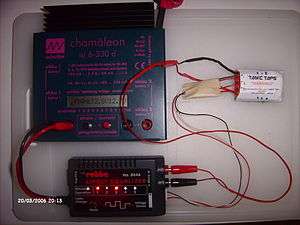Battery balancing


Battery balancing and battery redistribution refer to techniques that maximize the capacity of a battery pack with multiple cells (usually in series) to make all of the capacity available for use and increase each cell's longevity.[1] A battery balancer or battery regulator is a device in a battery pack that performs battery balancing.[2] Balancers are often found in lithium-ion battery packs for cell phones and laptop computers. They can also be found in battery electric vehicle battery packs.
Typically, the individual cells in a battery have somewhat different capacities and may be at different levels of state of charge (SOC). This is due to manufacturing variances, assembly variances (e.g., cells from one production run mixed with others), different histories experienced amongst the cells in a battery pack (e.g., charging/discharging, heat exposures, etc.) and must be accounted for to maximize life and service of the particular battery pack in use. Each battery pack will be, for these reasons, somewhat different and so every balancing circuit must be able to accommodate those differences. Without effective and appropriate balancing, discharging during use must stop when the cell with the lowest capacity is empty (even though other cells aren't); this limits the energy that can be taken from and returned to the battery.
Without balancing, the smallest capacity cell is a problem, and potentially a serious one. It can be easily overcharged or over-discharged whilst cells with higher capacities are only partial charged. The balance circuit should arrange for higher capacity cells to fully charge/discharge, while smaller capacity cells are charged/discharged suitably—which will necessarily be rather different. In a properly balanced battery pack, the cell with the largest capacity will be filled without overcharging any other (i.e., weaker, smaller) cell, and it can be discharged in use without over-discharging any other cell. Battery balancing is done by transferring energy from or to individual cells, until the SOC of the cell with the lowest capacity is equal to the battery's SOC.
Battery redistribution is sometimes distinguished from battery balancing by saying the latter stops at matching the cell's state of charge (SOC) only at one point (usually 100% SOC), so that the battery's capacity is only limited by the capacity of its weakest cell.
A full battery management system (BMS) might include active balancing as well as temperature monitoring, charging, and other features to maximize the life of a battery pack.[3]
Lithium ion rechargeable battery cells are rather more sensitive to overcharging, overheating, improper charge levels during storage, and other forms of mistreatment, than most commonly used battery chemistries. The reason is that the various lithium battery chemistries are susceptible to chemical damage (e.g., cathode fouling, molecular breakdown, etc.) by only very slight overvoltages (i.e., millivolts) during charging, or more charging current than the internal chemistry can tolerate at this point in its charge/discharge cycle, and so on. Heat accelerates these unwanted, but so far inescapable, chemical reactions and overheating during charging amplifies those effects. Because lithium chemistries often permit flexible membrane structures, lithium cells can be deployed in flexible though sealed bags, which permits higher packing densities within a battery pack. Some of the breakdown products (usually of electrolyte chemicals or additives) outgas when mistreated; such cells will become 'puffy' and are very much on the way to failure. In sealed lithium ion cylinders, the same outgassing has caused rather large pressures (800+ psi has been reported); such cells can explode if not provided with a relief failure mechanism. Compounding the danger is that many lithium cell chemistries include hydrocarbon chemicals (the exact nature of which is typically proprietary) which are flammable. Not only is explosion a possibility with mistreated lithium cells, but even a non-explosive leak can cause a fire.
Most battery chemistries have less dramatic, and less dangerous, failure modes. The chemicals in most batteries are often toxic to some degree, but are rarely explosive or flammable; many are corrosive, which accounts for advice to avoid leaving batteries inside equipment for long periods as the batteries may leak and damage the equipment. Lead acid batteries are an exception, for charging them generates hydrogen gas, which can explode if exposed to an ignition source (e.g., a lit cigarette or some such) and such an explosion will spray sulfuric acid in all directions. Since this is corrosive and potentially blinding, this is a particular danger.
Technology

Balancing can be active or passive.[4] The term battery regulator typically refers only to devices that perform passive balancing.
In passive balancing, energy is drawn from the most charged cell and dissipated as heat, usually through resistors.
In active balancing, energy is drawn from the most charged cell and transferred to the least charged cells, usually through DC-DC converters.
Battery balancing can be performed by DC-DC converters, in one of 3 topologies:
- Cell-to-battery
- Battery-to-cell
- Bidirectional
Typically, the power handled by each DC-DC converter is a few orders of magnitude lower than the power handled by the battery pack as a whole.
See also
References
- ↑ http://ww1.microchip.com/downloads/en/AppNotes/00231a.pdf
- ↑ Voltage controlled bypass regulator with digital interface. Manzanitamicro.com (2006-02-22). Retrieved on 2013-04-27.
- ↑ Battery Management and Monitoring Systems BMS. Mpoweruk.com. Retrieved on 2013-04-27.
- ↑ Wen, Sihua (September 2009). "Cell balancing buys extra run time and battery life" (PDF). Analog Applications Journal: 14.
External links
| Wikimedia Commons has media related to Balancer. |
Patents
- U.S. Patent 384,447, E. Julien, Regulating commutator for secondary battery